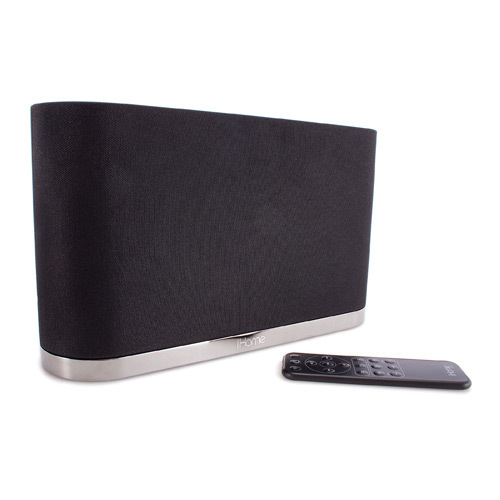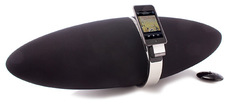
[ad_1]
After limited exposure, in the Editors’ Choice Bowers & Wilkins Zeppelin Air($599.95, 4 stars) and the JBL On Air Wireless ($349.95, 2.5 stars), Apple’s wireless audio system, Airplay, is finally coming to more products this fall. At $299.99 (direct), the iHome iW1 actually represents the bargain end of the AirPlay spectrum; most upcoming offerings lean more towards $400 and up. The portable iW1 sounds great at moderate volumes and can charge—or play music directly from—an iPhone via an included sync cable. At $300, it shouldn’t distort at high volumes, but if you must have an AirPlay dock but your budget is limited, this is the speaker system to check out.
Design
Measuring 7.3 by 12.5 by 3.7 inches (HWD), the iHome iW1 shares something in common with the Zeppelin Air: it’s dressed in black cloth speaker grilles with shiny metallic trim. The top panel of the tall, narrow speaker system is glossy black plastic, which, from left to right, is under-lit in pale white with touch-sensitive Volume, Track Backward, Play/Pause, and Track Forward controls and indicators for Power, Wi-Fi (lit when connected), and iPod (lit when one is connected via docking cable). The Volume control, rather than being two buttons for raising and lowering, is actually series of 16 tiny dots—tap your finger to the far left of the dots to lower the volume, while the 16th and farthest right dot is maximum volume. The advantage here is that it’s really easy to drastically lower the volume with just one tap, something very few devices offer despite the usefulness. The disadvantage is that, because the dots are set values, there’s no way to set the volume level at a point between the markers. Of course, you can always choose to use the volume slider on your iOS device’s screen to have a bit more control over the exact volume level.
The back panel is emblazoned with the iHome and Bongiovi DPS Acoustics logos—more on that in a bit. Along the lower back panel, there’s a battery button (press it and the volume dots on the top panel become power indicators for the internal rechargeable battery), a Power switch, a 3.5mm Aux input, a USB iPod docking cable connection, a firmware status LED, a Wi-Fi status LED, and a Wi-Fi setup button (for streaming music from your Mac or PC). A sync cable for iOS devices is included, as is a black plastic remote control that initially seems superfluous, given you can just use your iOS device as a remote with AirPlay. However, the remote works for iOS devices playing via the sync cable, so it can indeed be useful.
Underneath the body of the speaker, there’s a compartment into which the battery recharging base fits. The fit feels a bit awkward, but only because the base doesn’t snap into place. Instead, it sits flat on a table top and the speaker system just sits on top of it—they make contact automatically. It’s great when you want to pick the fully-charged speaker system up and walk with it without worrying about taking the base along accidentally; it remains sitting flat on the table or counter when you lift the unit. It can be a little awkward when you set the speaker unit down, however—you can’t see exactly where the compartment is, so it takes a little fiddling. Regardless, the portability of the system is a big plus. True, you still need Wi-Fi access in order to use the AirPlay function when operating the system off its battery, but that doesn’t seem like much of an issue given the sync cable and the remote’s ability to control whatever iOS device is connected via the cable. iHome rates the battery life at 10 hours.
Similar Products
Setting Up
Getting the iW1 streaming via AirPlay requires a Wi-Fi connection. iHome also provides a free app—iHome Connect—that your iOS device is prompted to download upon connecting to the speaker unit via the included docking cable. Once this is downloaded and you have logged on to your Wi-Fi network on your OS device, the AirPlay setup process takes seconds. Once it’s set, you can stream audio to the W1 simply by tapping the Airplay button on the bottom right-hand portion of your device’s screen.
Performance
There are few portable streaming audio docks available that are of decent-to-high quality, with the iHome iW1 falling somewhere in between the Logitech Wireless Boombox ($149.99, 3.5 stars) and the Editors’ Choice Bose SoundLink Wireless Mobile Speaker ($299.95, 4 stars) in terms of audio performance—but both of those systems use Bluetooth for streaming, not AirPlay. If you don’t crank the volume to max, or if you don’t listen to music that has deep bass frequencies, the iW1 offers a very enjoyable music experience. At moderate volumes, the low frequency response is not overly exaggerated, and it’s present enough to give a sense of fullness. Bass lines and percussion hits are well-defined, not muddy. On classical music, like John Adams’ “The Chairman Dances,” the lower register instruments have a nice resonance to them, and the mids and highs are clear without being overly bright. On the new album Father, Son, Holy Ghost by The Girls, the deeper frequencies of athe powerful kick drum are delivered with a pleasant amount of low-end presence, but it never overpowers the simple mix of guitars, vocals and bass playing in the ranges above it.
Things get a little ugly when you play a song like “Silent Shout” by The Knife, which features a tremendous deep bass electronic kick drum that separates the good subwoofers from the week, and the strong woofers from timid ones. Unfortunately, at maximum volume, the iW1’s drivers cannot handle the low-end thrust of deep bass racks. Thom Yorke’s “Cymbal Rush,” which features a highly resonant analog drum machine loop, distorts significantly at high volumes, as well. For a $300 dock, this is a disappointment, but as previously noted, much of the $300 price has to do with Airplay, not the quality of the drivers.
There was no discernible difference between playing audio through the included iPod sync cable off of an iPod touch and then sending the same audio via Airplay to the iW1. In both scenarios, at reasonable volumes, the system sounded solid. One issue with AirPlay that can arise at times, however, is the occasional tendency for the music streamed to get interrupted or stop, or for the connection between the device and the speakers to crash. This seems directly related, however, to how much activity there is on the Wi-Fi network that’s needed to stream the audio. If you’re using your laptop online while streaming from your iPad to the iW1, all on the same Wi-Fi network, don’t expect too many issues, but if you start downloading a movie, or have multiple browsers open—you get the idea. Eventually, the stream will likely start sputtering a bit if your Wi-Fi network is being pummeled. If the connection seems lost completely, you need to go back into the iHome Connect app and re-establish the connection between your device and the iW1, which takes seconds.
Bongiovi Acoustic DPS is a fancy feature that iHome has been touting for a couple years now. It’s impossible to restore the missing information in your low quality digital files, as the technology once purported to do, but Bongiovi Acoustics does help the iW1 sound good. That’s because it’s likely just an EQ curve—probably some boosted bass and boosted treble—that can help things sound a bit more full and clear on certain speakers. Whatever went in to Biongiovi Acoustics DPS, it didn’t keep the speakers from distorting at high volumes, which is unfortunate, considering plenty of speakers, like the Zeppelin Air, have built-in digital signal processing to prevent distortion at high volumes. Audio purists aren’t fans of this type of processing, as it messes with the music’s dynamics in order to prevent distortion, but purists also don’t like distortion itself.
Overall, the iW1 is a solid speaker unit, but at $300 there should be no distortion at high volumes. The Zeppelin Air is a far more graceful speaker system, but it costs twice as much. The AirPlay speaker system is a young category, so there’s not a whole lot else to which to compare the iW1 yet. The JBL On Air Wireless suffers from the same plight as the iW1: in order to be cheaper than the Zeppelin while still offering AirPlay, its speakers are the less expensive and weak link in the chain. Thus we have, between the iW1 and the On Air Wireless, two expensive speaker systems that don’t quite live up to their prices in terms of audio performance. Where the iHome iW1 saves itself is its portability: much can be forgiven when your speaker system lends itself well to a picnic or a hotel room on a vacation. The iW1 is imperfect, but if you want a portable AirPlay speaker dock for a lower-tier price, it’s the only real option. That said, for the same $300 price, Bose’s Bluetooth-based SoundLink Wireless Mobile Speaker is smaller, sounds better, and is our Editors’ Choice in the burgeoning category of portable wireless speaker systems.
More Speaker reviews:
- Yamaha YAS-101
- Harman Kardon Aura
- Klipsch Bar 40
- Boombotix Boombot Bass Station
- Harman Kardon Esquire Mini
- more
[ad_2]
Source link : https://www.pcmag.com/reviews/ihome-iw1

